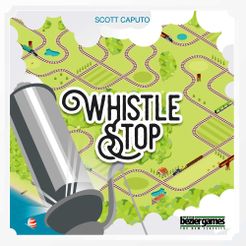
The golden age of railroads has begun! Whistle Stop takes us back to when the Golden Spike was used to signify the joining of the East Coast with the West Coast, a time of amazing technological innovation. In this game players are railroad owners attempting to leverage the new coast-to-coast market. We pick up supplies, and drop them off either at towns or destinations on the West Coast. Trains are fueled by coal, and carry timber, cotton, gravel (common resources) as well as cattle, whiskey and steel (rare resources). Special stations (like the General Store or Coal Mine) help us along the way.
This game has been on my “Shelf of Opportunity” for over a year. Not too long ago that finally changed. How did the game go? Was it fun? Would I play it again?
At one of my Wednesday Night Gaming Sessions earlier this year I brought along Whistle Stop. Here’s the short version: We had a blast. 🙂 There were three of us playing, which meant we each had five trains to work with. With more players (the game supports up to 5) the number of trains decreases. I can see how that might impact some strategies.
One of the best parts of the game is it has a defined ending point. Unlike many games that can overstay their welcome, Whistle Stop has two built-in timers. There is a set number of rounds, based on the number of players. But if a player manages to get all of their trains all the way across the board, the game ends at that point, even if it’s short of the expected number of rounds. There’s one decision point: Do I race to finish? Or do I take my time and try to leverage the various stops I can make? I have played other games where the game state determines when the game is over (I’m looking at you Terraforming Mars) and if the players are not actively trying to get to that state, the game could go on for a very long time. I like the predetermined number of rounds “timer” feature that Whistle Stop provides.
What about the game play? I like it! There are two basic options that you can pursue…you can pick up and deliver resources, or you can try to acquire stock in the various train companies. (I can hear the 18xx haters now…but trust me, it’s a very streamlined process.) You gain victory points every time a train reaches the end of the board and drops off the required resources. You gain victory points when you acquire stock, but there are additional points to be awarded at the end of the game if you hold the most shares. There is also an interesting tie breaker; if two players have the same number of shares of stock for a particular company, then the player who invested first wins.
A train in one area can gather a resource, while a train in another area can deliver that resource. I guess they have secretly invented the transporter from Star Trek to move the goods around so quickly. 😉 I don’t really have a problem with that.
The game looks good (although the pastel pallet seems a bit incongruous given the industrial background). The board fits together like a puzzle, allowing new parts to be added later (there is one expansion for this game that does just that). The cubes are larger than in many games which makes them easier to handle. The train “upgrades” that you can purchase (and in a mean twist steal from other players) slot neatly into your player dashboard.
The biggest issue with this game seems to be train movement. 😀 There was a FAQ provided on the publisher web site that did nothing but answer questions about movement. You see you can move your train one stop with coal, but only if you end up north, south, or west of your current location. You can move your train two stops with a whistle, and this allowed you to end up east of your current location. An opponent’s train in your way blocks your movement. One of your own trains in your way does not block movement, and in fact can sling-shot you forward more spaces than normally allowed. Except you can’t stop on a small stop where another train (yours or otherwise) is already stopped. But you can stop on a larger stop, even if there are other trains there. Unless one of the other players has the upgrade that keeps you from stopping at that spot. See? Simple! 😀
In all seriousness, this game can be explained relatively quickly and players pick up strategies as the game progresses. I have played it about a half dozen times now and am happy this game is in my collection. I have since picked up the “spiritual successor” called Whistle Mountain but have yet to play it. After all, a game needs to sit on my “Shelf of Opportunity” for at least a year before it gets played. Or so it seems. 😎